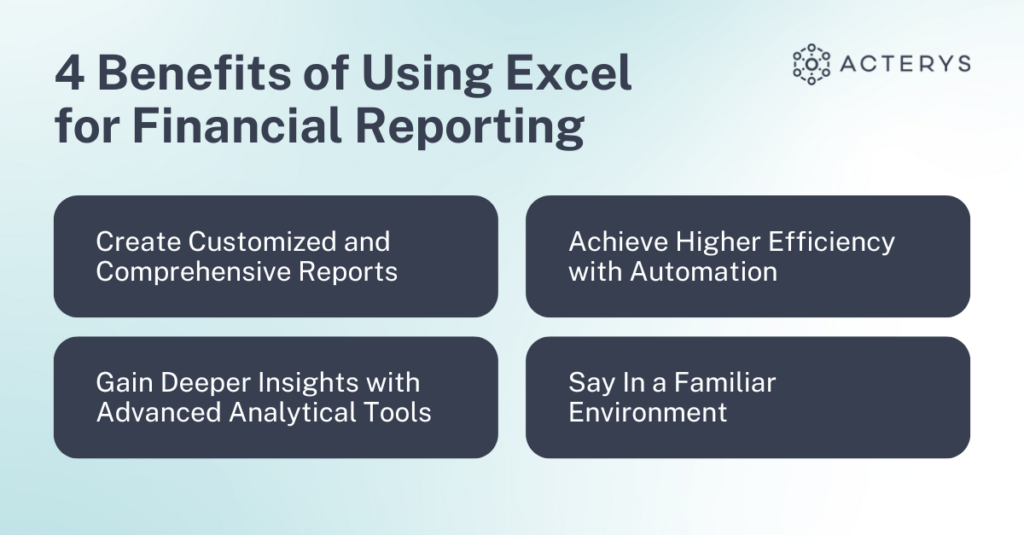
Table of Contents
Despite the rise of new technologies, Microsoft Excel’s flexibility and comprehensive features make it indispensable for financial reporting. The tool empowers users to handle data efficiently, from generating detailed financial statements to visualizing cash flows with charts. And the growing library of tips for Excel underscores how its customizable features give users unparalleled control.
Recent advancements in Excel, such as the powerful dynamic arrays and the versatile XLOOKUP function, have significantly expanded its utility. These tools create a dynamic environment where your financial reports can seamlessly update and evolve with your data, enabling real-time insights and sophisticated data modeling.
As Excel continues to evolve, check out these tips designed to enhance the accuracy, efficiency, and visual appeal of your reports. Whether you are a seasoned Excel user or just beginning, these insights will help you unlock the full potential of Excel for your financial reporting needs.
Should You Prepare Financial Reports in Excel?
Excel has stood the test of time and remains a go-to platform for many professionals managing financial data. Let’s explore why Excel continues to be a preferred choice for financial reporting and how it can enhance your reporting processes.
Customizable and Comprehensive Reporting
Preparing reports in Excel gives you unparalleled flexibility in creating financial reports tailored to your specific needs. Whether you’re designing detailed balance sheets, crafting comprehensive income statements, or visualizing cash flows, Excel’s versatile features make your financial reports easier to read and understand by providing all the information necessary for informed decision-making. Its wide range of templates and customizable options ensures that each report can be uniquely suited to your business requirements.
Advanced Analytical Tools
Modern Excel is equipped with powerful tools that go beyond simple spreadsheets. Dynamic arrays, for instance, allow you to perform complex data manipulations with ease, automatically expanding your formulas across cells. The XLOOKUP function simplifies searching and retrieving data, replacing older, more cumbersome lookup functions and streamlining your analysis process.
Efficiency and Automation
Automation in Excel can significantly reduce the time and effort required to prepare financial reports. Using macros and scripting, repetitive tasks can be automated, minimizing the risk of errors and freeing up time for more critical analysis. This means you can maintain a clear view of your company’s financial health and make sure high-level financial summaries are always up-to-date and accurate.
User-Friendly Interface
One of Excel’s greatest strengths is its widespread familiarity. Most business professionals have some experience with Excel, making it a readily accessible tool for financial reporting. Its user-friendly interface and extensive support resources make it easier to adopt and master compared to more specialized financial software.

5 Tips for Excel to Elevate Your Reporting Experience
Whether you’re preparing monthly financial statements, conducting in-depth analyses, or crafting detailed visual reports, these five essential tips will help you learn how to make a financial report in Excel that harnesses the full potential of the platform. Each tip is designed to streamline your processes, improve the clarity of your reports, and empower you to make data-driven decisions with confidence.
Tip #1: Separate Data & Presentation
Treating Excel as a database by directly copying and pasting large datasets can lead to significant performance and maintenance challenges. Instead, structure your data management approach to keep raw data separate from how it’s displayed in reports. This practice not only enhances the efficiency of your workflows but also ensures that your reports remain easy to update and error-free.
Modern tools like Power Query revolutionize how you integrate data into Excel. Power Query allows you to establish live connections to various data sources—such as databases, cloud services, or external files—without embedding data directly into your worksheets. This dynamic link ensures that your data is always current; with a simple refresh, your reports can automatically update to reflect the latest information. This method avoids the pitfalls of manual data entry and keeps your Excel files lightweight and performant.
When setting up your financial reports, use Power Query to manage data imports and transformations efficiently. For example, you can configure it to pull new data from a shared folder or an external database automatically, keeping your model updated with minimal effort.
Tip #2: Excel Formula Views
Unlike standard data presentation, formula views leverage OLAP (Online Analytical Processing) data sources, such as Power Pivot or SQL Server Analysis Services, to dynamically link your reports to their underlying data. This approach provides a flexible and robust foundation for your financial models, allowing for seamless integration and manipulation of complex datasets within Excel.
Creating formula views can begin from scratch or by converting an existing pivot table. This conversion process transforms static data into a dynamic, formula-based report, offering complete control over the layout and content. Be sure to duplicate your pivot table before converting it to ensure you have a backup of your original structure. With formula views, you can design asymmetric reports, such as comparing actual figures from the previous year against current-year budgets.
One of the key advantages of using formula views is their flexibility in updating and restructuring reports. You can build complex calculations and conditional formatting directly into your formulas, enabling real-time adjustments and customizations as your data changes. This capability is particularly valuable for financial reports that require frequent updates and detailed analysis, as it ensures your presentation remains aligned with the most current data, without the need for extensive manual reconfiguration.
Tip #3: Excel Pivot Tables
Excel pivot tables are a game-changer for financial reporting, yet many finance professionals aren’t fully leveraging their capabilities. Pivot tables allow you to effortlessly summarize and analyze vast amounts of data, providing unparalleled flexibility in how you view and interpret financial information.
One of the most powerful yet underutilized features of pivot tables is the ability to drill through data. By simply double-clicking on a cell within a pivot table, you can instantly access the underlying records that contribute to that summary. This feature is invaluable for in-depth data analysis, allowing you to explore the specifics behind aggregated numbers quickly. Additionally, the “Quick Explore” option lets you drill into details for another dimension attribute and combine Pivot Tables with Pivot Charts.
Tip #4: Writeback on Pivot Table
Traditionally, pivot tables have been used to summarize and analyze data, but with the right tools, they can also be used to update and modify data in real-time, providing a more interactive and integrated approach to financial planning and analysis.
The Acterys Excel Add-in extends the functionality of Excel by enabling writeback capabilities. This means that not only can you view and analyze your financial data, but you can also make adjustments directly in your pivot table, and those changes are reflected back in your underlying data sources. You can create scenarios, perform what-if analyses, and update key performance indicators (KPIs) on the fly, directly within Excel.
Tip #5: Conditional Formatting
Conditional formatting enhances the clarity and impact of your financial reports, and it’s especially helpful with pivot tables. It allows you to visually highlight key metrics and trends, making complex data easier to understand at a glance. For example, applying a bar format can immediately indicate the significance of a cell’s value, allowing users to quickly identify outliers and trends without diving deep into the numbers.
When working with OLAP sources like Acterys, conditional formatting can be finely tuned to apply to specific measure tuples within your pivot tables. This precise targeting helps in highlighting critical aspects of your data, such as performance metrics or financial ratios, providing a visual cue that directs attention to the most important figures.
Subtlety is key to making your reports both informative and aesthetically pleasing. Using light shades or gradient bars can effectively differentiate between data points without overwhelming the viewer. This approach ensures that your visual cues enhance understanding and draw attention to significant data patterns, making your reports more actionable and user-friendly. For instance, by using a bar format to show revenue variations across regions in a pivot table, you can provide a quick, visual summary of performance, facilitating easier comparison and analysis.
Bonus Tips for Excel Reports with Clean and Effective Layouts
Poorly designed layouts with brash colors and overcomplicated grids can detract from the data’s clarity and make it difficult for stakeholders to engage with the report. Here are some quick tips to help you learn how to create financial reports in Excel with cleaner, more effective layouts.
Simplify Your Design
Keep your spreadsheet design simple and uncluttered. Use consistent fonts and alignments to create a professional look. Avoid using overly bright colors or excessive gridlines that can overwhelm the viewer. Instead, use white space strategically to separate sections and make the report more readable. The goal is to make the data easy to scan and understand, allowing the key insights to stand out naturally.
Use Dynamic Titles
Make your reports more responsive by using Excel formulas to create titles that automatically update with your data. For instance, instead of manually updating the title each time the data changes, you can use a formula to link the title to a specific cell. Here’s how to do it:
- Insert a text box for your title.
- Click on the formula bar while the text box is selected.
- Enter a formula like =”Financial Results” &$C$6, where $C$6 is the cell containing the period or other key information.
This way, if the data in cell $C$6 changes, your title will automatically update to reflect the new information. This method keeps your report always accurate and contextually relevant, especially useful for reports that are regularly reviewed or updated by different users.
Focus on Data Presentation
Make sure that your data is presented in a clear and organized manner. Use tables and named ranges to keep your data structured and accessible. When creating charts and graphs, choose formats that best represent your data without adding unnecessary complexity. For example, use bar charts for comparing values and line charts for showing trends over time. Label your charts and axes clearly, and provide legends where necessary to help your audience quickly understand the data.

Financial Reporting and Planning Made Easy with Acterys Excel Add-in
Even with these tips for Excel, streamlining your financial reporting processes can be challenging, especially when dealing with complex data from multiple sources. The Acterys Excel Add-in simplifies this process by offering robust solutions for data consolidation, analysis, and visualization.
With the Excel Add-in, you can consolidate data from multiple sources into a single, coherent model. Whether you’re pulling data from ERP systems, CRM applications, or cloud services, Acterys simplifies the complex task of managing and integrating diverse datasets. This consolidated approach ensures your financial reports are comprehensive, accurate, and easy to manage.
Designed to scale with your needs, the Acterys Excel Add-in supports unlimited users and integrates seamlessly with Azure SQL Server and Power BI. The add-in automates key workflows, including reporting distribution. You can easily generate and share reports as Excel files or PDFs across your organization. It also offers robust security features that help track and control changes, with detailed audit trails and user-specific permissions.
Are you ready to maximize the value of Excel and your financial reporting? Get started with the Acterys Excel Add-in now.




